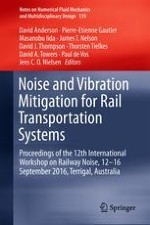2018 | OriginalPaper | Buchkapitel
A New Model for the Prediction of Track Sound Radiation
verfasst von : Xianying Zhang, David J. Thompson, Giacomo Squicciarini
Erschienen in: Noise and Vibration Mitigation for Rail Transportation Systems
Aktivieren Sie unsere intelligente Suche, um passende Fachinhalte oder Patente zu finden.
Wählen Sie Textabschnitte aus um mit Künstlicher Intelligenz passenden Patente zu finden. powered by
Markieren Sie Textabschnitte, um KI-gestützt weitere passende Inhalte zu finden. powered by
